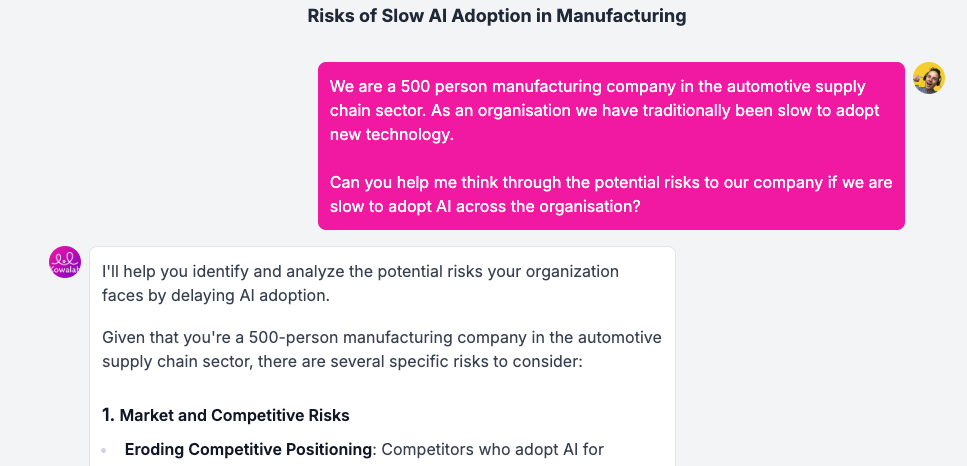Why Prompt Quality Matters
When you provide detailed context and clear objectives in your prompt, Kowalah can:- Understand your specific situation and constraints
- Draw on relevant AI industry expertise
- Provide more actionable and targeted guidance
- Save time by reducing follow-up questions
- Generate more useful documents and recommendations

The Anatomy of an Effective Prompt
For AI deployment scenarios, include as many of these elements as possible:1. Clear Objective
Start with what you’re trying to accomplish. For example:- “I need to evaluate vendors for a generative AI project”
- “I’m preparing to present our AI strategy to our board”
- “I need to prepare for a meeting with an AI vendor tomorrow”
2. Specific Instructions
Tell Kowalah exactly what you want it to do:- Create a specific document type
- Compare multiple options
- Analyze a particular vendor’s offering
- Suggest questions for a specific scenario
3. Contextual Background
Share relevant details about your organization and situation:- Organization context: Industry, size, regulatory requirements
- Technical environment: Existing systems, integration requirements
- Team context: Stakeholder roles, expertise levels
- Project stage: Where you are in the process
- Timeline and constraints: Budget, deadlines, or other limitations
4. Examples (When Applicable)
Provide examples of what you’re looking for:- Similar documents you’ve created before
- Formats you prefer
- Style or tone preferences
- What “good” looks like to you
5. Exception Handling
Mention any special cases or limitations to consider:- Risk factors specific to your industry
- Internal requirements or policies
- Particular concerns from stakeholders
6. Tone and Interaction Preferences
Let Kowalah know how you want to engage:- Do you want a direct answer or a guided exploration?
- Do you prefer technical depth or executive summaries?
- Are you looking for coaching through a process?
Putting It All Together
Here’s an example of a comprehensive prompt that incorporates all these elements:Refining Your Prompts
Don’t worry about crafting the perfect prompt on your first try. Kowalah can help you refine your request through conversation. If the initial response isn’t quite what you need, you can:- Clarify your objective: “That’s helpful, but I’m specifically looking for…”
- Add more context: “Let me provide some additional background…”
- Request adjustments: “Can you format this differently to focus more on…”
- Ask for alternatives: “What other approaches should we consider?”
Prompt Templates for Common AI Program Scenarios
Here are starting points for different stages of your AI deployment journey:AI Strategy and Vision
C-Suite Collaboration
AI Governance and Risk
Change Enablement
Best Practices
- Start with guided tasks when available, as they’re designed to walk you through specific activities similar companies have faced.
- Be specific about what you’re trying to accomplish
- Include relevant details but avoid overwhelming with unnecessary information
- Use project-based chats rather than standalone conversations for ongoing strategic activities
- Upload relevant documents to your project to provide additional context
- Follow up with clarifying questions if Kowalah’s response isn’t quite what you needed
Common Prompting Mistakes to Avoid
- Being too vague: “Help me with AI strategy” provides little guidance
- Omitting crucial context: Not mentioning industry-specific requirements or constraints
- Asking complex questions without breaking them down into manageable parts
- Expecting mind-reading: Not clearly stating your objective or expectations
- Overlooking your audience: Not specifying who the output is intended for

